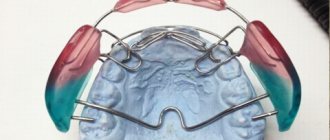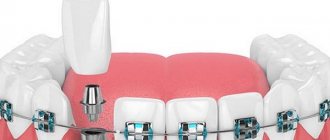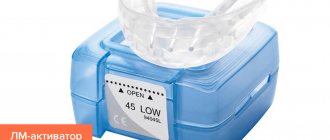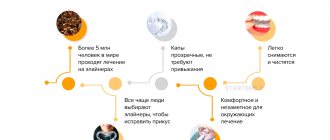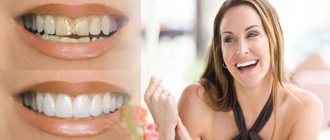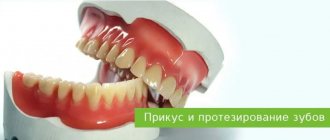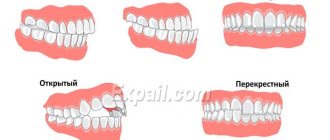Many patients, when they come to the orthodontist, are determined to receive treatment with braces. But sometimes additional influence is required. One example of such treatment is the non-removable Herbst appliance.
The Herbst appliance helps in eliminating malocclusions. Often the device is effective for distal occlusion defects (incorrect contact of the upper and lower teeth). A distal defect means that the upper row of teeth moves significantly forward in relation to the lower ones. All this is observed with the jaws closed.
Elimination of this defect is necessary not only for physiological reasons (impaired chewing, breathing or speech). Distal bite: protrusion of the upper jaw, curvature of the chin, thinness of the lips. Correction of the bite is accomplished by installing an orthodontic structure.
Features of the Herbst apparatus
- reliability of fixation, which is ensured by two hinges and steel rings;
- the structure is fixed on the supporting teeth;
- getting used to the device occurs in a short time;
- The seemingly massive device does not actually prevent a person from speaking and eating;
- treatment does not require diet;
- with the help of this device you can correct complex bite defects in just a year;
- changes in the patient’s profile occur immediately after installation of the structure;
- high cost of treatment;
- The probability of failure is very low, usually it is minor damage.
Advantages
The Herbst apparatus is not used in dentistry as often as before. Today, doctors offer simplified, cheaper designs, but this device has a number of advantages:
- strength and reliability;
- the device rests on the lateral teeth, so it is not noticeable during communication;
- the result is noticeable almost immediately after installing the device;
- continuous impact on the jaw significantly reduces the time to correct the defect;
- the ability to accurately predict the result;
- you don’t need to get used to the device for a long time with pain and discomfort;
- the patient can eat any food, the device will not become dirty;
- the device successfully treats jaw defects that provoke (or were provoked by) respiratory tract diseases;
- The device can be combined with any braces;
- in children under 17 years of age, it can replace surgical correction and treatment with a face bow;
- It is possible to install the device if there are problems with the enamel.
Patient reviews
Reviews about the Herbst apparatus are mostly positive, so you can safely decide to use this device. This is an excellent opportunity to get a 100% result and correct your bite in a short period of time.
In total, I had to wear the device for 5 months, although it was originally planned to be a little longer. I really liked the installation, I could have walked with it for at least a year. I'm happy with the result! Now I have perfect jaw closure. Teeth before and after the Herbst apparatus are heaven and earth.
Nina
I recently had the Herbst apparatus removed. Overall, I’m happy with everything, but I want to say that it’s better to put rings instead of crowns. If there is such an opportunity, you should definitely use it. The doctor struggled with putting on the crowns for an hour and the same with removing them. The procedure is not pleasant, but it is bearable. After all, the main thing is to solve your dental problem.
Alina
After six months of using the device, it was possible to remove the distal bite, which had previously been impossible to achieve with other orthodontic devices.
But now the bottom row has leaned forward slightly. Now it is returned by a spring to the correct position. The doctor promises that everything will get better. Anton
Types of devices and design elements
The Herbst apparatus is a complex structure. Most of the parts of the device are made of medical alloy, which prevents allergic reactions and damage to the device.
Components:
- crowns for support, which are placed on the side teeth;
- hinged beams (2 pcs.) of a telescopic design, which allows you to open your mouth;
- metal rings for securing the ends of the beams to the crowns;
- curved metal arches (sometimes required for increased stability of crowns).
Types of Herbst apparatus:
- Classical. It is only attached to artificial metal crowns.
- Optimal. Attached to the arch of the bracket system and to the crowns. Allows you to simultaneously correct the bite and correct the dentition.
- Plastic base. The installation of such a structure depends on the initial condition of the teeth. Partial and full basis possible. The design is recommended for people with complete or partial absence of teeth (edentia).
Indications
The main indication for installation is distal class 1 occlusion according to Angle. The design helps to extend the movable lower jaw and fix it. Often, treatment with the Herbst apparatus is combined with the installation of a brace system.
The Herbst apparatus can be used not only for the correction of orthodontic defects that have developed from underdevelopment of the lower jaw and excessive growth of the upper jaw. Sometimes the design is used to treat orthopedic problems, in combination with other devices.
General provisions
1.1.
Limited Liability Company "LABORATORY DENTA" OGRN 1177746504100, INN 7707385301 location address: 107023, Moscow, st. Semenovskaya M., 11A, building 14, floor 1 room. 1, (hereinafter referred to as the “Company”), undertakes to maintain the confidentiality of data and information provided by users (“User”) when using the site https://eurokappa.pro, as well as when using and participating in the Company’s chats in WhatsApp, Viber, messengers, Telegram (hereinafter referred to as “Messengers” or “Messenger”). 1.2. This Policy establishes the rules in accordance with which the Company collects and/or processes data and information that the User provides or that becomes available to the Company during the User’s use of the site and/or Messengers.
1.3. The condition for using the site and/or Messenger is the User’s consent to this Policy, posted on the Company’s Website at: https://eurokappa.pro. With each access and/or actual use of the site and/or Messenger, the User agrees to the terms of this Policy.
Operating principle
The visual result is observed immediately after installation of the device. With constant tension, the lower jaw moves forward. During treatment, the ligaments and muscles of the jaw are stretched, which allows the mandibular joint to be correctly installed.
The effectiveness and surgical treatment is ensured through continuous exposure to the dentition. Within a short time after installation, the facial profile becomes more natural and harmonious. Similar designs are considered to be the Sabbath and Forsus springs.
Preparing for installation
First, the doctor examines the oral cavity in detail. It is necessary to check the integrity and health of all teeth, especially molars. Preparation for installation consists of treating all teeth, replacing old fillings, and sanitizing the dentition.
Also during this period, the degree of the occlusion defect is assessed, impressions are taken, which are then sent to the laboratory.
Stages of treatment
- Preparation. At this stage, the oral cavity is sanitized and caries is prevented. Sometimes surgical preparation of the cavity for installation of the Herbst apparatus is required. This could be plastic surgery of the labial frenulum, the vestibule of the mouth, or tooth extraction. Additional measures at this stage: consultations with a speech therapist, myogymnastic exercises for the muscles of the mouth and lower jaw, normalization of breathing. Doctors strongly advise getting rid of bad habits.
- Correction. Some patients require alignment of dental arches and correction of jaw position. It is recommended to use removable orthodontic appliances: with springs, to expand the arches.
- Installation. The Herbst appliance can be combined with other orthodontic devices.
- Treatment. Alignment of teeth in both jaws. Retainers allow you to consolidate the result immediately after removing the device. At this stage, it is necessary to achieve tight fissure-tubercle contact (tooth relief).
- Consolidation. Stabilization of the bite is carried out thanks to the correct position of the tongue, muscle functionality, and nasal breathing. To ensure tight jaw contact, removable and non-removable retainers and elastopositioners (special silicone mouthguard) are used.
Fit
- Crown preparation. The sixth tooth is treated on the upper jaw, and the fourth molar on the lower jaw. The procedure is carried out under local anesthesia: 2 mm are removed from the upper surface of the enamel, and 1.5 mm from the sides. This is necessary to ensure that the crown is fixed and does not interfere. Finally, the teeth are treated with a product that increases the porosity of the enamel (phosphoric acids). A substance is also applied that promotes adhesion (bonding of the tooth and crown).
- Installation of crowns. Crowns are placed on the treated molars. For this, high-strength cement or composite is used. Power rods and bushings are secured using bandage rings and C-clamps. If the Herbst apparatus is attached to a bracket system, then first the structure is attached to the arch with special centers. The centers have gaps that allow them to catch on the arc, then the rods are attached to them with mini-screws. The centers should be located near the supporting teeth (on the upper jaw between 5 and 6, on the lower jaw 3-4).
- Correction of bushings and rods. The structure is inspected immediately after the procedure and regularly during treatment. If necessary, you can shorten them. It is necessary to maintain a balance: short rods slip out of the bushings, and long rods injure the mucous membrane.
Wearing rules
- exclude strong mechanical impact;
- watch the C-shaped clamps (if deformed, consult a doctor);
- monitor the traction (partial and complete flight can cause severe injury to soft tissues and the larynx).
Obtaining a functional impression.
After fitting an individual tray, they begin to obtain a functional impression.
Obtaining an impression consists of the following steps:
1) fitting an individual spoon;
2) applying the impression mass to the tray;
3) inserting a spoon with the mass into the oral cavity;
4) forming the edges of the impression and conducting functional tests;
5) making an impression and evaluating it. It should be accepted as a rule that a functional impression that ensures good fixation of the prosthesis can only be obtained if the anatomical impression reflects all the structures of the prosthetic field and some functional features of the tissues surrounding the prosthetic bed. When a functional impression , they are only refined. There are unloading or decompression and compression impressions. Typically, the value of a compression or relief impression is associated with the fixation of the prosthesis and its effect on the mucous membrane of the prosthetic bed. However, the value of a particular impression-taking technique is determined by the influence of the prosthesis on the course of the process of atrophy of the alveolar process. Unloading (decompression) impressions are obtained without pressure or with minimal pressure of the impression mass on the tissue of the prosthetic bed. The disadvantage of the unloading impression is that the buffer zones of the hard palate are not subject to compression, and all the pressure from the prosthesis is transferred to the alveolar process, increasing its atrophy.
When receiving a decompression impression, the impression material must reflect every detail of the oral mucosa without distortion so that the microrelief of the prosthesis base exactly matches the surface structure of the prosthetic bed. Therefore, such impressions can only be obtained using impression compounds that have high fluidity and do not require much effort to remove the impression. Such masses include low-viscosity silicone pastes: exaflex, xanthoprene, alfazil, as well as zinc oxide eugenol pastes. The impression obtained using liquid plaster (according to Brachman) usually provides just such a perception of the surface relief of the tissues of the prosthetic bed. Some authors believe that if several holes are drilled in the impression tray to drain excess impression material, then the pressure of the impression mass on the mucous membrane can be reduced. It is known that the fixation of prostheses made using decompression impressions is weak, but they can be used if there are certain indications.
Such indications include:
1) significant or complete atrophy of the alveolar processes and mucous membrane;
2) increased sensitivity of the mucous membrane;
3) uniformly pliable mucous membrane of the prosthetic bed. Compression impressions are designed to take advantage of the pliability of the mucous membrane, so they are removed under high pressure to compress the buffer zones. When they talk about a compression impression, they primarily mean compression of the vessels of the prosthetic bed. The decrease in tissue volume and its vertical compliance are directly dependent on the degree of filling of the vascular bed. The use of compression impressions is recommended in the presence of loose mucous membranes with good pliability.
A prosthesis made using a compression impression does not load the alveolar ridge; outside of chewing, it rests only on the tissues of the buffer zones, like pillows. When chewing, under the influence of masticatory pressure, the vessels of the buffer zones are emptied of blood, the prosthesis settles somewhat and transfers pressure not only to the buffer zones, but also to the alveolar part. Thus, the alveolar process is unloaded, which prevents its atrophy. A prosthesis made using a compression impression has good fixation, because the pliable mucous membrane of the valve zone is in closer contact with the edge of the prosthesis. The compression impression is taken under continuous pressure , which ensures compression of the vessels of the mucous membrane of the hard palate and their emptying. To obtain such a print, certain conditions must be met:
1) you need a hard spoon;
2) the impression must be taken using a low-flow mass or thermoplastic mass;
3) compression must be continuous, stopping only after the mass hardens. Continuity can be ensured by manual force (voluntary pressure). But it is more convenient and correct to take a compression impression under the chewing pressure of the muscles that elevate the mandible, i.e. under bite pressure, which is created by the patient himself, or with the help of special devices that make it possible to create a strictly defined pressure (dosed) taking into account the individual characteristics of the tissues of the prosthetic bed and masticatory muscles. To obtain a functional impression, thermoplastic materials are used, such as dentofol, otrokor, orthlast, etc.
The convenience of using thermoplastic masses is explained by their following properties: 1) they have an extended plasticity phase, which allows for functional tests necessary to obtain a high-quality impression;
2) during impression taking they always have the same consistency; 3) they do not dissolve in saliva; 4) distribute pressure evenly; 5) allow you to repeatedly insert an impression into the oral cavity and carry out correction, because new portions of the mass merge with old portions without deforming the print. However, thermoplastic masses have certain disadvantages. These include: inaccurate print due to low fluidity; deformation in the presence of retention points. When cooled with water, they harden unevenly and may become deformed when removed from the mouth. It should be recognized that when using the above methods for obtaining an impression, in some cases it is not possible to ensure a complete functional reflection of the prosthetic field. The tissues of the prosthetic field and the active muscles surrounding it are not the same in relief, relative volume, physiological status during chewing or speaking, as well as during the day. The physical and emotional state of a person also has a great influence on the condition of the prosthetic bed and the surrounding muscles. Whatever method of taking an impression is used, further adaptation of the prosthesis base to the tissues of the prosthetic field, the relationship of the dentition and the force of chewing pressure is necessary, as well as adaptation of the patient and fitting of the prosthesis over a certain period of time. The wide variety of clinical conditions encountered for prosthetics necessitates the use of a differentiated impression. We should proceed from the general position that there is no single method shown in all cases. In this regard, the method of obtaining an impression in each specific case must be chosen taking into account the patient’s age, constitutional and individual characteristics of the jaw tissues, i.e. in all cases a differentiated approach is required. In cases where the tissues of the prosthetic bed in different areas are not identical in their relief and structure, the biophysical properties of each element of the prosthetic bed should be taken into account. When taking an impression, tissues with pronounced spring properties should be under greater load, while tissues of unloaded zones (in the area of the torus, incisive papilla, etc.) should not be overly loaded. Selective pressure on the underlying tissues, depending on their anatomical and functional characteristics and biophysical properties, may be important due to the need to prevent premature atrophy of the soft and bone tissues of edentulous jaws by redistributing the chewing pressure of the prosthesis base. Consequently, depending on the anatomical and physiological characteristics of the prosthetic bed, it is possible to obtain images of the mucous membrane in various functional states. At the same time, it is recommended to obtain unloading impressions in case of thin, atrophic and excessively pliable (“dangling” ridge) mucous membrane. Compression casts are indicated for loose, highly pliable mucous membranes. The best effect can be achieved only by using differentiated casts obtained with different degrees of compression of the mucous membrane, taking into account its compliance in different areas of the prosthetic bed.
Using retainers
The duration of treatment depends on the patient's age and the degree of the defect. Often this is 3-6 months with regular orthodontic consultations. Wearing the device for six months allows you to correct complex jaw deformities in children under 15 years of age.
Since the device is aimed at treating complex defects that can only be corrected by surgery, retention is very important. The quick effect of wearing the device is not final. After removing the system, you need to consolidate the results.
Dentists use special devices to keep the jaws straight, called retainers. Wearing retainers prevents teeth from returning to their original position.
After braces, retainers are indicated for several hours a day. After the Herbst apparatus, additional fixation is required for 20 hours a day. This is why permanent retainers are recommended. They are invisible during conversation, but provide fixation of the dentition.
On average, retainers are worn for another 2 years after the device. Sometimes patients have to wear retainers for the rest of their lives. During this period, the muscles and ligaments in the joint are strengthened, and functional adaptation occurs.
Orthodontists offer different retainers to choose from. The most popular are removable transparent aligners or non-removable systems that are attached to the inside of the teeth. The orthodontist can also recommend an LM activator. This is a special type of trainer - a removable silicone device for eliminating dental defects. It must be worn several hours a day and while sleeping.
Correct wearing and retention
To get a guaranteed result, you should follow some simple rules when using the Herbst device. Intense mechanical impact should not be allowed; it can damage the system or disrupt the fixation of the crowns.
It is important to monitor the appearance of the installation. If the C-clamps change shape, this part will need to be replaced immediately. Otherwise, the device will lose its functionality, and problems will arise with full opening of the mouth and comfortable chewing of food. The most dangerous thing is when the rod flies out, it can lead to damage to the mucous membrane.
Treatment time depends on the degree of pathological position of the jaw and the age of the patient. As a rule, correction lasts about six months if you visit a doctor regularly.
Retention is of great importance, because treatment is aimed at eliminating complex defects. After removing the device, the results must be recorded.
Specialists use special devices to keep the jaws in the correct position. There are a variety of retainer designs available. If after braces they are worn for several hours a day, then in the case of the Herbst apparatus, the wearing time increases significantly. For this reason, it is better to use permanent type retainers. They are not visible when you smile, and they reliably fix the dentition.
Retainer
Typically, retainers are worn for two years after removal. In rare cases, you have to use them throughout your life. The most popular are removable transparent structures or systems that are attached to the inside. Sometimes doctors recommend an LM activator. This is a silicone device that allows you to get rid of dental defects. It is worn for several hours a day and at night.
The cost of installation depends on the type of structure. Minimum price - 4500 rubles. Teeth preparation and traction correction are not included in the total cost. A system with any additional parts will cost 15,000–30,000 rubles.
Thus, the Herbst appliance is the optimal way to treat significant malocclusions. The device boasts fast, guaranteed results. Even today, this is one of the best designs for removing a jaw defect.
Cost of the device and patient opinions
The price depends on the type of construction. The minimum cost of a template apparatus with four crowns and rods is 4,500 rubles. Treatment does not include tooth preparation or traction correction. A device with a base and additional elements (for example, springs) costs from 15,000 to 30,000 rubles.
According to patients, the Herbst apparatus is the optimal treatment for complex jaw defects. This treatment gives guarantees and in most cases implements them. The undeniable advantages of the device are the short treatment period and good results. Even in the 21st century, this is one of the best devices for eliminating jaw defects.
Sources used:
- Stancker TG et al. alocclusion influence on balance and posture: a systematic review // Manual Therapy, Posturology & Rehabilitation Journal
- Kurlyandsky V. Yu. Orthopedic dentistry. — 4th, corrected. - M.: Medicine, 1977.
- Official website of the Russian Dental Association

